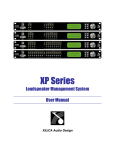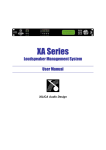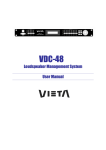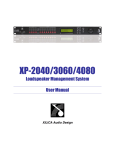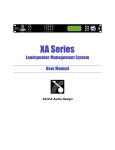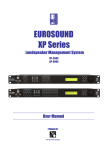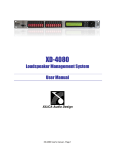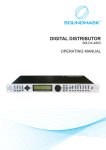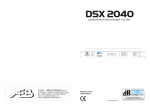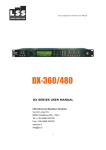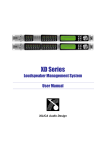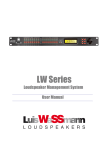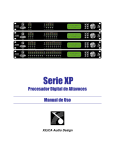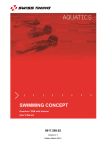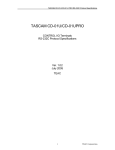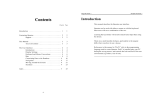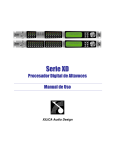Download LMS 242 - NEXT
Transcript
LMS 242 Loudspeaker Management System User Manual Important Safety Instructions 1. READ THESE INSTRUCTIONS All the safety and operating instructions should be read before the product is operated. 2. KEEP THESE INSTRUCTIONS The safety and ope rating instructions should be retained for future reference. 3. HEED ALL WARNINGS All warnings on the product and in the operating instructions should be adhered to. 4. FOLLOW ALL INSTRUCTIONS All ope rating and use of instructions should be followe d. 5. DO NOT USE THIS APPARATUS NEAR WATER Do not use the product near water. For example, near a bathtub, washbowl, kitchen sink, or laundry tub, in a wet basement, or near a s wimming pool, and the like. 6. CLEAN ONLY WITH DRY CLOTH Unplug the unit from the wall outlet before cleaning. Do not use liquid cleane rs or aerosol cleaners. Use a damp cloth for cleaning. 7. DO NOT BLOCK ANY VENTILATION OPENINGS Slots and openings in the cabinet back or bottom are provided for ventilation, to ensure reliable ope ration of the limit and to protect it from overheating. These openings must not be blocked or covered. The openings should never be blocked by placing the product on a bed, sofa, rug, or similar surface. This product should never be placed near or over a radiator or heat source. This product should not be placed in a built-in installation such as a bookcase or rack unless prope r ventilation is provided or the manufacture's instructions have been adhered to. LMS 242 User's manual - Page 2 8. DO NOT INSTALL NEAR ANY HEAT SOURCES This Product s hould be situated away from heat sources such as radiators, stoves, or other products (including amplifiers) that produces heat. 9. DO NOT DEFEAT THE SAFETY PURPOSE OF THE POLARIZED OR GROUNDING-TYPE PLUG A Polarized plug has two blades with one wider than the othe r. A grounding-type plug has two blades and a third grounding prong. The wide blade or the third prongs are provided for your safety. If the provided plug does not fit into your outlet, consult an electrician for replace ment of the obsolete outlet. 10. PROTECT THE POWER CORD FROM BEING WALKED ON OR PINCHED PARTICULARLY AT PLUGS, CONVENIENCE RECEPTACLES, AND THE POINT WHERE THEY EXIT FROM THE APPARATUS. 11. ONLY USE ATTACHMENTS/ACCESSORIES SPECIFIED BY THE MANUFACTURER. 12. USE ONLY WITH CART, STAND, TRIPOD, BRACKET, OR TABLE SPECIFIED BY THE MANUFACTURER, OR SOLD WITH THE APPARATUS. WHEN A CART IS USED, USE CAUTION WHEN MOVING THE CART/APPARATUS TO AVOID INJURY FROM TIP-OVER. Do not place this unit on an unstable cart, stand, tripod, bracket, or table. The unit may fall, causing serious injury to someone, and serious damage to the appliance. A unit and cart combination should be moved with care. Quick stops, excessive force, and uneven surfaces may cause the product and cart combination to ove rturn. 13. UNPLUG THIS APPARATUS DURING LIGHTNING STORMS OR WHEN UNUSED FOR LONG PERIODS OF TIME. For added protection for this unit during a lightning storm, or when it is left unattended and unused for long pe riods of time, unplug it from the wall outlet and disconnect the antenna or cable system. This will prevent damage to the unit due to lightning and power line surges. 14. REFER ALL SERVICING TO QUALIFIED SERVICE PERSONNEL. SERVICING IS REQUIRED WHEN THE APPARATUS HAS BEEN DAMAGED IN ANYWAY, SUCH AS WHEN THE POWER SUPPLY CORD OR PLUG IS DAMAGED, LIQUID HAS BEEN SPILLED OR OBJECTS HAVE FALLEN INTO THE APPARATUS, THE APPARATUS HAS BEEN EXPOSED TO RAIN OR MOISTURE, DOES NOT OPERATE NORMALLY, OR HAS BEEN FROPPED. 15. WARNING: TO REDUCE THE RISK OF FIRE OR ELECTRIC SHOCK, DO NOT EXPOSE THIS APPARATUS TO RAIN OR MOISTURE. 16. APPARATUS SHALL NOT BE EXPOSED TO DRIPPING OR SPLASHING AND NO OBJECTS FILLED WITH LIQUIDS, SUCH AS VASES, SHALL BE PLACED ON THE APPARATUS. LMS 242 User's manual - Page 3 Table of Contents Table of Contents.................................................................... 4 1.0 Introduction....................................................................... 5 2.0 Features.............................................................................. 6 3.0 Front Panel Functions ...................................................... 7 4.0 Rear Panel Functions ....................................................... 9 5.0 Powering Up the Device .................................................. 10 6.0 Operating the Channel Menus........................................ 11 7.0 Operating the System Menus ......................................... 18 8.0 Quick Reference .............................................................. 24 9.0 PC Control Software ....................................................... 25 10.0 Specifications ................................................................. 26 11.0 Warranty ........................................................................ 28 LMS 242 User's manual - Page 4 1.0 Introduction The LMS 242 is a digital loudspeaker management system designed for the touring or fixed sound instal ation markets. The absolute latest in available technology is utilized with 40-bit floating point processors and high performance 24-bit Analog Converters. The high-bit DSP prevents noise and distortion induced by truncation errors of the commonly used 24bit fixed-point devices. A complete set of parameters include I/O levels, delay, polarity, 8 bands of parametric EQ per channel, 31 bands of GEQ per input, multiple crossover selections and full function limiters. Precise frequency control is achieved with its 1 Hz resolution. Inputs and outputs can be routed in multiple configurations to meet any requirement. The LMS series can be control ed or configured in real time on the front panel or with the intuitive PC GUI accessed via the RS-232, USB or Ethernet interface. Software upgrade for CPU and DSP via PC keeps the device current with newly developed algorithms and functions once available. Multiple setup storage and system security complete this professional package. Shipped contents: - LMS Unit - User Manual - LMS Software CD - Power Cord LMS 242 User's manual - Page 5 2.0 Features > Up to 2 Inputs and 4 Outputs with flexible routing > 40-bit floating point DSP > 96kHz Sampling Rate > High Performance 24-bit A/D Converters > 1 Hz Frequency Resolution > 8 Parametric Equalizers for each Input and Output > 31 Bands GEQ for each Input > Multiple Crossover types with Ful Function Limiters > Precise Level, Polarity and Delay > CPU and DSP upgrade via PC > Individual Channel Buttons with Linking capability > 2-Line x 16 Character Backlit LCD Display > Ful 5-segment LED’s on every Input and Output > Storage of up to 30 Preset Setups > Security Lock > Ethernet (Optional), USB and RS232 Interface for PC Control LMS 242 User's manual - Page 6 3.0 Front Panel Functions 2 3 2 5 6 7 8 4 1. USB – a standard Type B USB connector. Device driver from the provided software CD must be instal ed prior to usage. 2. RS232 – a standard female DB9 socket. A straight through cable is required for PC connection. 3. Mute (Channel Menu) Buttons – Mute or un-mute input and output channels. When an input channel is muted, a red LED will come on for indication. When the <<Menu or Menu>> key is held down, the Mute Buttons selects the corresponding channel for the LCD menu display and is acknowledged by a green LED below the button. The last modified menu wil be displayed on the LCD. Multiple channels can be linked or unlinked by pushing the desired channels. This eases programming for same parameters across multiple channels. Multiple Inputs can be linked together and multiple outputs can be linked together. Inputs and Outputs are linked separately. 4. Channel Menu LED modification. – Indicates the activated channels for data 5. Peak Level LED – Indicates the current peak level of the Signal: LMS 242 User's manual - Page 7 Signal, -12dB, -6dB, -3dB, Over/Limit. The Input Limit LED references to the device's maximum headroom. The Output Limit LED references to the threshold of the output limiter. 6. LCD – Shows al the necessary information to control the unit. 7. Menu Buttons – There are 6 menu keys: Menu>> (Menu Up), <<Cursor (Cursor Down), <<Menu (Menu Down), Cursor>> (Cursor Up), Enter/Sys/Speed, Exit. The functions of each key is explained below: <<Menu: Go to previous menu screen. Holding this button down while pressing Mute key wil go to the specify channel menu. Menu>>: Go to next menu screen. Holding this button down while pressing Mute key will go to the specify channel menu. <<Cursor: Go to previous cursor in the menu screen. Cursor>>: Go to next cursor in the menu screen. Enter/Sys/Speed: Enter is used only in the System Menu to proceed with selected actions. Sys enters the System Menu from the main menu. Speed modifies delay and frequency (1 Hz resolution mode) data values by 100X. Exit: Exit to the Main Menu. 8. Rotary Thumb Wheel – Changes parameter data values. The wheel has travel velocity sensing which ease large incremental data modifications. For modifying delay and frequency (1 Hz resolution), pressing the Speed key simultaneously will increment/decrement the data value by 100X. LMS 242 User's manual - Page 8 4.0 Rear Panel Functions 1,2,3 4 5 1. Main Power – Connects via a standard IEC socket. A compatible power cord is supplied with the unit. The voltage input is 90-240VAC, 50-60Hz. 2. Main Fuse – T2.5A-250V. Slow blow type. 3. Power switch – Controls power On/Off. 4. Ethernet (Optional )– RJ45 connector for Ethernet control. The device should be connected to a router/switch/hub via a straight through CAT-5 cable. 5. Analog Inputs and Outputs – Separate 3-pin connectors are provided for each audio input and output. The device's output stage employs the balanced impedance topology. Al I/O connectors have pin 1 as ground (shield), pin 2 as + and pin 3 as -. LMS 242 User's manual - Page 9 5.0 Powering Up the Device After powering up the unit, the following initialization screen is displayed on the LCD: NEXT LMS242 LMS242 v9.03 The initialization process takes several seconds and during that period the unit boots and displays the device model and firmware version. After the initialization process is finished the LMS displays its main screen: NEXT LMS242 LMS242 v9.03 The screen shows the current program number and program name assigned to the unit. If the program number is 31 and the name is MEMORY, it means that no program is assigned, the last data before previous power down is recalled instead. Now the LMS is ready to operate. LMS 242 User's manual - Page 10 6.0 Operating the Channel Menus Channel Linking – While holding down the <<Menu or Menu>>, more than 1 channel from the same group (Input or Output group) can be selected to link the channels together. The green LEDs below the Mute buttons are lit for the linked channels. Any modification of the data for the selected channel wil be applied to the linked channels as well. To cancel the linking, simply deselect the desired channel while the <<Menu or Menu>> key is stil pressed, or just press the Exit key to deselect al channels. 6.1 Input/Output Signal LEVEL: The level (or gain) ranges from -40.00dB to +15.00dB in 0.25dB steps. I1:______ Signal LEVEL:0.00dB POL: The polarity (or phase) can be normal (+) or inverted (-). I1:______ Signal POL:+ DELAY: The maximum delay permitted is 650ms, in steps of approximately 10us. It can be displayed in ms, ft or m. The time unit of the delay is set in the System Menu. Please refer to page 21 for more details. I1:______ Signal DELAY:000.000ms LMS 242 User's manual - Page 11 6.2 Input/Output Equalizer EQ#: Each input channel has 8 bands of equalization. This control selects one of the 8 available bands. I1:______ EQ1 EQ#:1 BYPASS: This control will un-bypass (Off) or bypass (On) the currently selected band. I1:______ EQ1 BYPASS:Off TYPE: The 5 types of EQ that can be used are: parametric (PEQ), low shelf (LOst nd SHF), high shelf (HI-SHF), 1 degree al -pass (AP-1), and 2 degree allpass (AP-2). I1:______ EQ1 TYPE:PEQ FREQ: The EQ center frequency ranges from 20Hz to 30kHz in either 1Hz steps or 1/36 octave steps. The frequency steps can be selected in the System Menu. Please refer to page 21 for more details. I1:______ EQ1 FREQ:1000Hz BW: The EQ bandwidth ranges from 0.02 to 3.61 octaves in steps of 0.01 octave. The equivalent Q value is automatically shown besides the octave st value. For 1 degree al -pass (AP-1) filter, the bandwidth will sets the phase shift at the centre frequency. This phase shift is gradually changed from 180 degrees above the centre frequency to the specified value. I1:______ EQ1 BW:0.33 Q=4.36 I1:______ EQ1 DEG:15.5 deg LMS 242 User's manual - Page 12 LEVEL: The EQ level (or gain) ranges from -30.00dB to +15.00dB in 0.25dB steps. I1:______ EQ1 LEVEL:0.00dB 6.3 Input Graphic Equalizer GEQ#: The graphic equalizer has 31 bands of equalization from 20Hz to 20kHz. This control selects one of the 31 available bands. The frequency corresponding to each band is also shown. I1:______ GEQ1 GEQ#:1 f=20 LEVEL: The GEQ level (or gain) ranges from -30.00dB to +15.00dB in 0.25dB steps. I1:______ GEQ1 LEVEL:0.00dB BYPASS: This control will un-bypass (Off) or bypass (On) the entire GEQ for this channel. I1:______ GEQ1 BYPASS:Off LMS 242 User's manual - Page 13 6.4 Input/Output Crossover TYPL: The 3 available filter types for the low frequency crossover point (high pass) are: Butterworth, Linkwitz Riley or Bessel. O1:______ XOver TYPL:Off FRQL: The filter cut-off frequency for the low frequency crossover point (high pass) ranges from 20 to 30kHz in either 1Hz steps or 1/36 octave steps. The frequency steps can be selected in the System Menu. Please refer to page 21 for more details. O1:______ XOver FRQL:1000Hz SLPL: The filter slope for low frequency crossover point (high pass) ranges from 6 to 48dB/octave. If the selected filter type is Linkwitz Riley, the available slopes are 12, 24, 36 or 48 dB/octave only. O1:______ XOver SLPL:24dB TYPH: The 3 available filter types for the high frequency crossover point (low pass) are: Butterworth, Linkwitz Riley or Bessel. O1:______ XOver TYPH:Off LMS 242 User's manual - Page 14 FRQH: The filter cut-off frequency for the high frequency crossover point (low pass) ranges from 20 to 30kHz in either 1Hz steps or 1/36 octave steps. The frequency steps can be selected in the System Menu. Please refer to page 21 for more details. O1:______ XOver FRQH:1000Hz SLPH: The filter slope for high frequency crossover point (low pass) ranges from 6 to 48dB/octave. If the selected filter type is Linkwitz Riley, the available slopes are 12, 24, 36 or 48 dB/octave only. O1:______ XOver SLPH:24dB Filter configuration Low crossover point High crossover point None FTRL Off FTRH Off Highpass FTRL not Off FTRH Off FRQL Lowpass FTRL Off FTRH not Off FRQH Bandpass FTRL not Off FTRH not Off FRQL FRQH LMS 242 User's manual - Page 15 6.5 Input Compressor THRESH: The compressor threshold ranges from -20 to +20dBu in 0.5dB steps. O1:______ Comp THRESH:+20.0dB ATTACK: The compressor attack time ranges from 0.3 to 1ms in 0.1ms steps, then ranges from 1 to 100ms in 1ms steps. O1:______ Comp ATTACK:10ms RELEASE: The compressor release time can be set at 2X, 4X, 8X, 16X or 32X the attack time. O1:______ Comp RELEASE:8XAtck RATIO: The compressor ratio is the slope in which the signal is compressed. It ranges from 1:1 to 1:40. O1:______ Comp RATIO: 1:1 6.6 Input/Output Channel Name NAME: A 6 characters name can be assigned to each channel. I1:______ Name NAME:______ LMS 242 User's manual - Page 16 6.7 Output Limiter THRESH: The limiter threshold ranges from -20 to +20dBu in 0.5dB steps. O1:______ Limit THRESH:+20.0dB ATTACK: The limiter attack time ranges from 0.3 to 1ms in 0.1ms steps, then ranges from 1 to 100ms in 1ms steps. O1:______ Limit ATTACK:10ms RELEASE: The limiter release time can be set at 2X, 4X, 8X, 16X or 32X the attack time. O1:______ Limit RELEASE:8XAtck 6.8 Output Source IN1-8: This sets the input channel source for the current output channel. It can be used to mix the input source (in dB) or disable it (Off). If more than one input sources are enabled, they will be added together as the source for the 1 current output channel. O1:______ Source IN1:Off 1 O1:______ Source IN2:-14.00 Number of Inputs is dependent on the model. LMS 242 User's manual - Page 17 7.0 Operating the System Menus The System Menus allow the user to control and change parameters that are related to the system behavior and general operation. It can be accessed by pressing the Sys key in the main menu (when no Input/Output or System Menu is activated). All System Menus require pressing the Enter key to confirm and save the settings. 7.1 Preset Recall The LMS has a built in non-volatile memory that can store up to 30 different preset setups. P: This control selects which program to recal from the non-volatile memory. The program name is displayed to the right of the program no. Recall P:1 ____________ S YS TEM 7.2 Preset Store The LMS has a built in non-volatile memory that can store up to 30 different preset setups. A program can be stored using this menu. The old program with the same program number wil be replaced. Once the program is stored in the flash memory, it can be recal ed at a later time, even after power down. P: This control selects which preset location in the non-volatile memory to be saved. S YS TEM Store P:1 LMS 242 User's manual - Page 18 NAM: A descriptive name of up to 12 characters can be assigned to each program. Store NAM:____________ S YS TEM 7.3 Device Configuration MODE: The unit assigns the Input source for the corresponding outputs when the Mode of Operation is changed. The crossover point parameters like the filter type, cut-off frequency and slope have to be configured manual y in the Crossover Menu for each Output Channel. Config S YS TEM MODE:None Mode: None Stereo 2-Way Out 1 Any In1 Stereo 3-Way Stereo 4-Way In1 In1 Out 2 Any In1 In1 In1 Out 3 Any In2 In1 In1 Out 4 Any In2 In2 In1 Out 5 Any Any In2 In2 Out 6 Any Any In2 In2 Out 7 Any Any Any In2 Out 8 Any Any Any In2 *Note: The configuration mode configures the input sources when selected. The user can change the source afterwards if desired. It does not keep the configuration in memory. 7.4 Copy Channels Copy Channels from the source to the target. When the Source and Targets are both Inputs and Outputs, al audio parameters will be copied. When one of the Source or the Target is an input while the other is an output, only the Level, Polarity, Delay, EQ, Crossover, and Channel Name are copied. LMS 242 User's manual - Page 19 SOURCE: This is the channel to be copied from. S YS TEM Copy SOURCE:In1 TARGET: This is the channel to be copied to. S YS TEM Copy TARGET:In2 7.5 General Settings FREQ MODE: This changes the frequency control mode for EQ and crossover filters. It can be 36 steps/octave or All Frequencies (1 Hz resolution). Generl FREQ MODE:All S YS TEM DELAY UNIT: This sets the time unit for input and output delay to ms, ft, or m. Generl DELAY UNIT:ms S YS TEM LMS 242 User's manual - Page 20 7.6 Ethernet Settings The network settings are separated into 3 menus. Eth-IP: A unique IP address should be assigned to each unit in the network. Eth-IP :255.255.255.255 S YS TEM Eth-GW: The gateway address of the network. Usually, this should be the IP address of your router/switch/hub address. Eth-GW :255.255.255.255 S YS TEM Eth-SM: The sets the subnet mask used by your network. S YS TEM Eth-SM :255.255.255.255 7.7 Communication Settings NOTE: User must power cycle the unit for this settings to take effect. BAUD RATE: The sets the baud rate of the serial communication. LMS Software uses a baud rate of 115200, it should be left unchanged for most user. S YS TEM Comm BAUD RATE:115200 LMS 242 User's manual - Page 21 DEVICE ID: This control assigns a device ID from 1 to 16 to the unit. This ID is only useful when a network of more than 1 unit is used in conjunction with 1 or more XPanel. S YS TEM Comm DEVICE ID:1 PORT: This allows the user to select which serial communication device to use, 2 RS232/USB or Ethernet. S YS TEM Comm PORT:RS232/USB 7.8 Security Password The factory default password is blank (“____”), it can be changed to any combination of 4 characters in this menu. OLD PW: The user is required to enter the old password first to modify the password. Passwd OLD PW:____ S YS TEM NEW PW: The new password desired. Passwd NEW PW:____ S YS TEM 2 This menu is only shown in older firmware versions. LMS 242 User's manual - Page 22 7.9 Security Lock The LMS enables the user to secure the unit and prevent undesired changes in the setup. In order to lock or unlock the unit the user must enter the correct password. The user can only lock or unlock al menus using the front panel, LMS Software is required to lock or unlock individual menu. PASSWORD: The password is 4 characters in length. The factory default of a new unit does not require a password. The user can change the password via LMS Software or the Set Password menu. S YS TEM Secure PASSWORD:____ LMS 242 User's manual - Page 23 8.0 Quick Reference Parameters Mic Level Level Polarity Delay Menu <<Menu >> Mic Signal Signal Signal Field <<Cursor> > LEVEL LEVEL POL DELAY EQ Number EQ Level EQ Frequency EQ Bandwidth GEQ Number GEQ Level GEQ Bypass EQ EQ EQ EQ GEQ GEQ GEQ EQ# LEVEL FREQ BW GEQ# LEVEL BYPASS XOver Low Type XOver FTRL XOver Low Frequency XOver Low Slope XOver High Type XOver XOver XOver FRQL SLPL FTRH XOver High Frequency XOver High Slope Compressor Attack Time Compressor Release Time Compressor Ratio Limiter Threshold Limiter Attack Time Limiter Release Time XOver XOver Comp Comp Comp Comp Limit Limit Limit FRQH SLPH THRESH ATTACK RELEASE RATIO THRESH ATTACK RELEASE Source Source Channel Name Name 1, 2, 3, 4, 5, 6, 7, 8 NAME Compressor Threshold Min Max 0 -40 +45 +15 0 Steps 3 0.25 +/62400 1 Units dB dB 10us steps 1 -30 20 0.02 1 -30 8 1 dB 0.25 +15 Hz 1 30,000 Octave 0.01 3.61 1 31 dB 0.25 +15 Off / On Off / Butterworth / Linkwitz-Riley / Bessel 20 30,000 1 Hz 6 48 6 dB/octave Off / Butterworth / Linkwitz-Riley / Bessel 20 30,000 1 Hz 6 48 6 dB/octave -20 +20 0.5 dBu 0.3 100 0.1 / 1 ms 2 / 4 / 8 / 16 / 32X Attack time 1:1 to 1:40 -20 +20 0.5 dBu 0.3 100 0.1/1 ms 2 / 4 / 8 / 16 / 32X Attack time Off LMS 242 User's manual - Page 24 +15 0.25 6 characters dB 9.0 PC Control Software The LMS 242 is shipped with a special PC Graphic User Interface (GUI) application - LMS Software. LMS Software gives the user an option to control the unit from a remote PC via the serial communication link. The GUI application makes it much easier to control and monitor the device, al owing the user to get the whole picture on one screen. Programs can be recal ed and stored from/to PC’s hard drive, thus expanding the storage to become virtual y limitless. LMS Software can be connected to the LMS 242 via RS232, USB or Ethernet. USB requires the installation of additional driver. The user is given an option to install it during the installation of LMS Software, and if the user did not install it at that time, they may choose to do so by running the USB driver 3 installer from the provided software CD. 3 The latest version of LMS Software and USB driver are available at LMS web site. LMS 242 User's manual - Page 25 10.0 Specifications Inputs and Outputs Input Impedance: Output Impedance: Maximum Level: Type: >10k Ohms 50 Ohms +20dBu Electronical y balanced Audio Performance Frequency Response: +/- 0.1dB (20 to 30kHz) Dynamic Range: 115dB typ (unweighted) CMMR: > 60dB (50 to 10kHz) Crosstalk: < -100dB Distortion: 0.002% (1kHz @+4dBu) Digital Audio Performance Processor: 40-bit 96kHz Sampling Rate: High Performance 24-bit Analog Converters: 1.5ms Propagation Delay: Front Panel Controls Display: Level Meters: Buttons: Dial Encoder: 2 x 16 Character Backlit LCD 5 segment LED Mute/Edit Controls Menu Controls Embedded Thumb Wheel Connectors Analog Inputs: Analog Outputs: RS-232: USB: Power: 3-pin Female XLR 3-pin Male XLR Female DB-9 Type B Standard IEC Socket General Power: Dimensions: Weight: 90-240 VAC (50-60Hz) 19”x1.75”x9” (483x44x229 mm) 10 lbs / 4.5 kg LMS 242 User's manual - Page 26 Audio Control Parameters Gain: -40 to +15dB in 0.25dB steps Polarity: +/Delay: Up to 650ms per I/O Parametric Equalizers (8 per I/O) Type: Parametric, Hi-shelf, Lo-shelf, Phase 1, Phase 2 Gain: -30 to +15dB in 0.25dB steps Bandwidth: 0.02 to 3.61 octaves (Q=0.5 to 72) 31-Band Graphic Equalizers (1 per Input) Gain: -30 to +15dB in 0.25dB steps Crossover Filters (2 per I/O) Butterworth, Bessel, Linkwitz Riley Filter Types: 6 to 48dB/oct Slopes: Limiters (1 per Output) -20 to +20dBu Threshold: 0.3 to 100ms Attack: 2 to 32X the attack time Release: System Parameters No. of Presets: Program Names: Delay Units: Frequency Modes: 30 12 character length ms, ft, m 36 steps/oct, 1Hz resolution Note: Specifications subject to change without notice LMS 242 User's manual - Page 27 11.0 Warranty The LMS 242 is warranted covering materials and workmanship for a period of five (1) years, as determined by the date of retail purchase (according to the sales receipt from an authorized dealer) or the date of manufacture if the sales receipt is not available (according to the serial number). This warranty applies to the product; therefore, the remainder of the warranty period wil be automatical y transferred to any subsequent owner. This warranty applies only to failure of a LMS product caused by defects in materials and workmanship during the stated warranty period. It does not apply to a unit that has been subjected to abuse, accident, modification, improper handling/instal ation, or repairs made without factory authorization or by anyone other than authorized LMS Field Service Stations. This warranty is void if the serial number has been defaced, altered or removed. Products covered by this warranty will be repaired or replaced at the option of LMS, without charge for materials or labor, provided al the terms of this warranty have been met. For factory service, please cal or email for a Return Authorization (R/A) number before shipping. If the product is shipped, the fol owing information must be included in the package: 1. Owner’s complete name, daytime phone number, return street address and return authorization number. 2. The serial number of the product being returned and a copy of the retail sales receipt, if possible. 3. A complete description of the problem(s) experienced, including a brief description of how the equipment is being used and other equipments involved. LMS 242 User's manual - Page 28 LMS 242 User Manual v9.03 (Apr 2011)





























